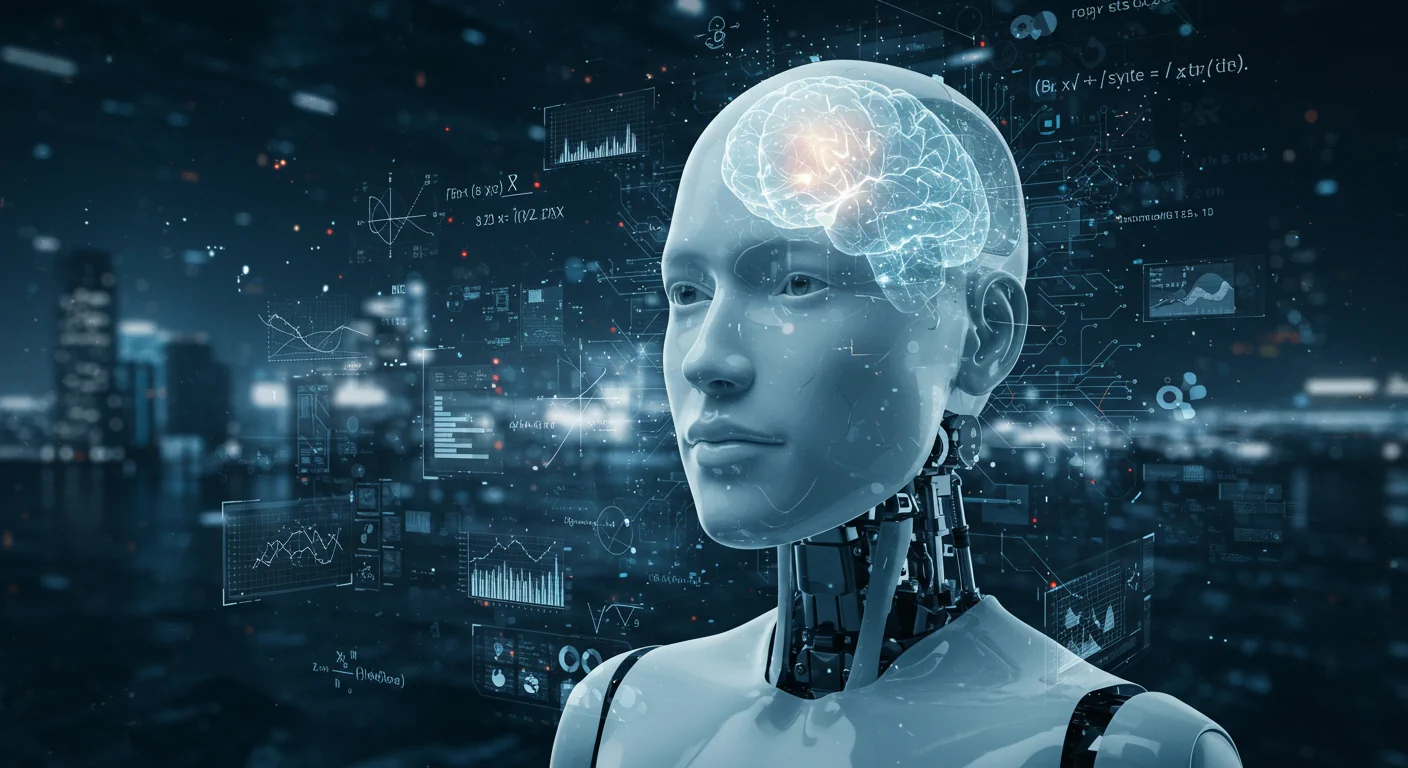Unveiling the Machines’ Capacity to Think
At the heart of the ongoing technological revolution lies a field of computer science that fascinates and intrigues: Artificial Intelligence (AI). Far from being mere science fiction, AI has become a driving force behind countless technologies we use daily, from virtual assistants on our smartphones to recommendation systems on streaming platforms and autonomous cars under development. Understanding what Artificial Intelligence is and how it works is fundamental to navigating the increasingly automated and intelligent world around us.
Therefore, for anyone seeking to understand the future of technology and its impact on our lives, knowledge about Artificial Intelligence is essential. This article has been carefully crafted for you, the beginner, who wishes to demystify this complex field and discover the fundamentals that govern the ability of machines to simulate human intelligence.
Simplifying the Concept: What Does Artificial Intelligence Mean?
In essence, Artificial Intelligence (AI) is a branch of computer science dedicated to creating computer systems and programs capable of simulating human cognitive abilities, such as learning, reasoning, perception, problem-solving, and decision-making. In other words, AI seeks to develop machines that can “think” and act intelligently, learning from experience, identifying patterns, making predictions, and adapting their behavior to new situations.
Thus, Artificial Intelligence is not limited to a single type of technology but encompasses a vast set of approaches, algorithms, and techniques aimed at endowing machines with intellectual capabilities similar to those of humans. The ultimate goal is to create systems that can perform tasks that traditionally require human intelligence.
The Pillars of Artificial Intelligence: Fundamental Concepts
Artificial Intelligence is based on several fundamental concepts that underpin its development and application:
- Machine Learning (ML): Firstly, machine learning is a subfield of AI that allows systems to learn from data without being explicitly programmed for each specific task. ML algorithms identify patterns in data and use these patterns to make predictions or decisions.
- Artificial Neural Networks (ANNs): Next, inspired by the structure of the human brain, artificial neural networks are computational models composed of layers of interconnected nodes (artificial neurons) that process information and learn by identifying complex relationships in data.
- Deep Learning (DL): Additionally, deep learning is a subfield of machine learning that uses neural networks with multiple layers (deep neural networks) to learn complex data representations. It has proven particularly effective in tasks such as image recognition, natural language processing, and speech recognition.
- Natural Language Processing (NLP): Furthermore, NLP is a field of AI that focuses on computers’ ability to understand, interpret, and generate natural human language (such as text and speech). It enables more intuitive interaction between humans and machines.
- Computer Vision: Finally, computer vision is a field of AI that allows computers to “see” and interpret the visual world from images and videos. It involves tasks such as object recognition, face detection, and scene analysis.
- Robotics: AI is often integrated with robotics to create intelligent robots capable of performing complex tasks, navigating dynamic environments, and interacting with humans autonomously.
- Intelligent Agents: An intelligent agent is an entity (software or robot) capable of perceiving its environment, making decisions, and acting to achieve its goals.
The Scale of Intelligence: Main Types of Artificial Intelligence
Artificial Intelligence is classified into different types according to its capabilities and functionalities:
- Narrow AI or Weak AI: Firstly, this type of AI is designed and trained to perform a specific task intelligently. Most AI applications we see today (such as virtual assistants, recommendation systems, and facial recognition software) fall into this category.
- Artificial General Intelligence (AGI) or Strong AI: Next, AGI is a hypothetical type of AI with the intellectual capability of a human being, capable of understanding, learning, and applying knowledge across diverse tasks, just like a person. AGI has not yet been achieved.
- Artificial Superintelligence (ASI): Additionally, ASI is a hypothetical type of AI that would surpass human intelligence in all aspects, including creativity, problem-solving, and general knowledge. ASI is a widely debated concept and still far from reality.
Classifying AI based on its capabilities:
- Reactive Systems: Furthermore, this type of AI has no memory of the past and reacts only to present information. A classic example is Deep Blue, the IBM computer that defeated world chess champion Garry Kasparov.
- Limited Memory: Finally, this type of AI can store past information for a short period and use it to make decisions. Most speech recognition systems and some autonomous cars fall into this category.
- Theory of Mind: This is a hypothetical type of AI that would have the ability to understand the emotions, beliefs, and intentions of other agents (humans or other machines), just like humans.
- Self-Awareness: This is a hypothetical type of AI that would be aware of itself, with feelings, desires, and self-consciousness, similar to human consciousness.
The World in Transformation: Practical Applications of Artificial Intelligence
Artificial Intelligence is already transforming numerous sectors and aspects of our lives:
- Health: Disease diagnosis, drug discovery, personalized medicine, virtual assistants for patients, for example.
- Finance: Fraud detection, risk analysis, automated financial advisory (robo-advisors), additionally, algorithmic trading.
- Retail: Recommendation systems, customer service chatbots, inventory optimization, consumer behavior analysis.
- Transportation: Autonomous cars, route optimization, intelligent traffic management.
- Manufacturing: Predictive maintenance, automated quality control, intelligent industrial robots.
- Education: Personalized virtual tutors, student performance analysis, creation of adaptive educational content, for example.
- Entertainment: Recommendation systems for movies and music, AI-generated content, interactive virtual characters.
- Security: Facial recognition for identification, analysis of suspicious behavior patterns, detection of cyber threats.
- Agriculture: Crop monitoring, optimization of irrigation and fertilization, harvest prediction.
- Virtual Assistants: Siri, Alexa, Google Assistant, capable of answering questions, performing tasks, and controlling smart devices.
- Natural Language Processing: Automatic translation, sentiment analysis in texts, finally, customer service chatbots.
This list illustrates only a few of the myriad applications of AI, and new applications constantly emerge as the technology advances.
The Engine of Learning: How Does Artificial Intelligence Learn?
The ability to learn is a fundamental characteristic of Artificial Intelligence, utilizing different techniques to allow systems to learn from data:
- Supervised Learning: The system is trained with a labeled dataset, where the correct output for each input is known. The goal is for the system to learn to map inputs to the correct outputs and be able to make accurate predictions on new, unlabeled data.
- Unsupervised Learning: The system is trained with an unlabeled dataset, and the goal is for it to discover hidden patterns, structures, or clusters in the data on its own.
- Reinforcement Learning: The system learns through interaction with an environment, receiving rewards or punishments for its actions. The goal is for the system to learn to make sequences of decisions that maximize the reward over time.
- Neural Networks and Deep Learning: As mentioned earlier, neural networks, especially deep networks, are capable of learning complex data representations by adjusting their internal connections (weights) during the training process.
The Heart of the Decision: How Does Artificial Intelligence Make Decisions?
The way Artificial Intelligence makes decisions varies depending on the type of system and the task to be performed. Some common mechanisms include:
- Rule-Based: Simpler systems may follow a predefined set of “if-then” rules to make decisions.
- Statistical Models: Machine learning algorithms build statistical models from training data; thus, decisions are made based on the probabilities and patterns identified by the model.
- Optimization: In optimization problems, AI can use algorithms to find the best possible solution within a set of constraints.
- Neural Networks: In neural networks, the decision is the result of neuron activation and the propagation of information through the network’s layers.
Challenges and Ethical Considerations: The Dark Side of Artificial Intelligence?
Although Artificial Intelligence offers numerous benefits, its development and application also raise significant challenges and ethical considerations:
- Algorithmic Bias: AI algorithms can reproduce and even amplify biases present in training data, leading to unfair or discriminatory decisions.
- Data Privacy and Security: AI often relies on large amounts of data, raising concerns about the privacy and security of this information.
- Unemployment and Automation: The automation of tasks by AI systems can lead to job losses in certain sectors.
- Transparency and Explainability: In some complex AI systems (like deep neural networks), it can be difficult to understand why a particular decision was made (the so-called “black box”).
- Control and Safety of Strong AI: The development of artificial general intelligence or superintelligence raises questions about the control of these machines and potential risks to humanity.
- Accountability: In case of errors or damages caused by autonomous AI systems, determining responsibility can be complex.
These issues require careful debate and the creation of regulations and ethical guidelines to ensure that AI is developed and used responsibly and beneficially for society.
The Horizon of Intelligence: The Future of AI
The future of Artificial Intelligence is promising and full of potential:
- Continuous Advances: AI is expected to continue advancing at an accelerated pace, with the development of more sophisticated algorithms and the application of AI in new areas.
- More Integrated AI: AI will become even more integrated into our daily lives, present in more devices and services.
- Personalization: AI will enable the creation of highly personalized products and services, adapted to the individual needs of each user.
- Human-Machine Collaboration: AI will increasingly act as a tool to augment human capabilities, with humans and machines working together to solve complex problems.
- New Industries and Markets: AI will create new industries and markets that we cannot even imagine yet.
- Global Challenges: AI has the potential to help address some of the world’s biggest challenges, such as climate change, health, and poverty.
For beginners, understanding the fundamentals of AI is the first step to participating in this transformation and understanding the role this technology will play in the future.
Conclusion: A Fascinating Journey into the World of Artificial Intelligence
In summary, Artificial Intelligence is a vast and fascinating field that is rapidly shaping our world. For beginners, unveiling its basic concepts, understanding its different types, and exploring its myriad practical applications is an essential journey to comprehend the future of technology.
Remember that AI is not a magical entity, but the result of complex algorithms and large volumes of data. By continuing to learn and stay updated on advancements in this field, you will be better prepared to understand the impact of AI on your life and society as a whole.
Therefore, embrace curiosity and continue exploring the exciting world of Artificial Intelligence. The future of technology and intelligence itself is being written now, and you are part of this story.
Did you like the article What is Artificial Intelligence – Unveiling the Mind of the Machine? Check out more here.








